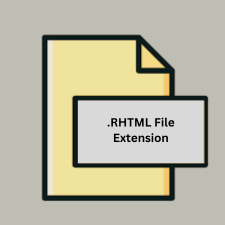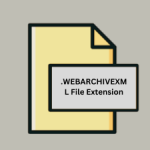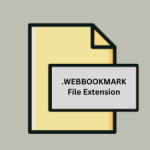.RHTML File Extension

What is an RHTML file?
The .RHTML file extension represents a Ruby HTML Web Page. These files are HTML files that contain embedded Ruby code, which is processed on the server side before the HTML is sent to the client’s browser. This integration allows for dynamic content generation based on Ruby code execution.
More Information.
Ruby on Rails was created by David Heinemeier Hansson in the early 2000s. .RHTML files were introduced as part of this framework to enable developers to write dynamic web pages using Ruby code embedded within HTML. The primary purpose was to simplify web development by allowing Ruby code to directly generate and manipulate HTML content.
Origin Of This File.
.RHTML files are primarily associated with Ruby on Rails, a popular web application framework written in Ruby. Ruby on Rails allows developers to build web applications with dynamic content generation by combining HTML and Ruby code.
File Structure Technical Specification.
- File Extension:
.RHTML - File Type: Text-based (HTML with embedded Ruby code)
- Structure: The file consists of standard HTML markup with Ruby code embedded within special tags, such as
<% %>for Ruby code and<%= %>for Ruby expressions that output content. - Technical Specification: When a
.RHTMLfile is requested by a web browser, the Ruby code within the file is processed by the Ruby interpreter on the server. The result is a standard HTML page that is then sent to the client’s browser.
How to Convert the File?
Windows
- Set Up Ruby on Rails Environment:
- Install Ruby and Ruby on Rails if not already installed.
- Use tools like RailsInstaller to set up a Rails environment easily.
- Run the Rails Server:
- Navigate to your Rails application directory using the command line.
- Start the Rails server using the command:
rails server.
- Generate the HTML:
- Access the
.RHTMLfile through a web browser by navigating to the appropriate URL on the local server (e.g.,http://localhost:3000/your_page). - The server will process the
.RHTMLfile and render the resulting HTML.
- Access the
- Save the Output:
- Right-click on the webpage in the browser and choose “Save Page As” to save the HTML file.
Linux
- Set Up Ruby on Rails Environment:
- Run the Rails Server:
- Navigate to your Rails project directory in the terminal.
- Start the Rails server with:
rails server.
- Generate the HTML:
- Open a web browser and navigate to the URL corresponding to the
.RHTMLfile on the local server (e.g.,http://localhost:3000/your_page).
- Open a web browser and navigate to the URL corresponding to the
- Save the Output:
- Save the webpage as an HTML file from the browser.
macOS
- Set Up Ruby on Rails Environment:
- Run the Rails Server:
- Open Terminal and navigate to your Rails project directory.
- Start the server with:
rails server.
- Generate the HTML:
- Open Safari or another web browser and navigate to the appropriate URL (e.g.,
http://localhost:3000/your_page).
- Open Safari or another web browser and navigate to the appropriate URL (e.g.,
- Save the Output:
- Save the webpage as an HTML file from the browser.
Android
Direct conversion on Android is challenging due to the lack of a server environment. Instead, you can:
- Use a Web Service:
- If you have access to a Ruby on Rails server, navigate to the
.RHTMLfile’s URL using a mobile web browser. - Save the generated HTML from the browser.
- If you have access to a Ruby on Rails server, navigate to the
- Use a Remote Desktop App:
- Access a remote desktop or virtual machine with Ruby on Rails installed and perform the conversion there.
iOS
Direct conversion on iOS is also limited. Instead:
- Use a Web Service:
- Navigate to the URL of the
.RHTMLfile on a Ruby on Rails server using Safari or another browser. - Save the resulting HTML page.
- Navigate to the URL of the
- Use a Remote Desktop App:
- Access a remote desktop or virtual machine with Ruby on Rails to convert the file.
Other Environments
- Use a Ruby on Rails Server:
- Ensure you have a Ruby on Rails server set up in your environment.
- Navigate to the
.RHTMLfile’s URL through the server.
- Save the HTML Output:
- Once you have the generated HTML in a browser, save the page as an HTML file.
Advantages And Disadvantages.
Advantages:
- Dynamic Content: Allows for the creation of dynamic web pages based on Ruby code execution.
- Integration: Seamlessly integrates with the Ruby on Rails framework, facilitating rapid web development.
- Maintainability: Ruby code can be used to generate repetitive HTML content, making it easier to maintain and update.
Disadvantages:
- Server-Side Processing: Requires server-side processing, which can impact server load and performance.
- Limited Client-Side Interactivity: The generated HTML page may not support dynamic client-side interactions without additional JavaScript.
How to Open RHTML?
Open In Windows
- Text Editors: Use text editors like Notepad++, Sublime Text, or Visual Studio Code to view and edit the Ruby and HTML code.
- Ruby on Rails Server: Use a Ruby on Rails server to process the file and view the resulting HTML in a web browser.
Open In Linux
- Text Editors: Use text editors like Vim, Emacs, or Gedit.
- Ruby on Rails Server: Use a Ruby on Rails server to process the file and view the resulting HTML in a web browser.
Open In MAC
- Text Editors: Use text editors like TextEdit, Sublime Text, or Visual Studio Code.
- Ruby on Rails Server: Use a Ruby on Rails server to process the file and view the resulting HTML in a web browser.
Open In Android
- Text Editors: Use apps like AIDE or Juju Text Editor to view and edit the code.
- Web Browser: You cannot directly process
.RHTMLfiles on Android, but you can view static HTML content if converted.
Open In IOS
- Text Editors: Use apps like Textastic or Koder to view and edit the code.
- Web Browser: You cannot directly process
.RHTMLfiles on iOS, but you can view static HTML content if converted.
Open in Others
Web Browsers: The .RHTML file must be processed by a Ruby on Rails server to generate HTML content viewable in web browsers. The raw .RHTML file itself cannot be rendered as HTML without server-side processing.













